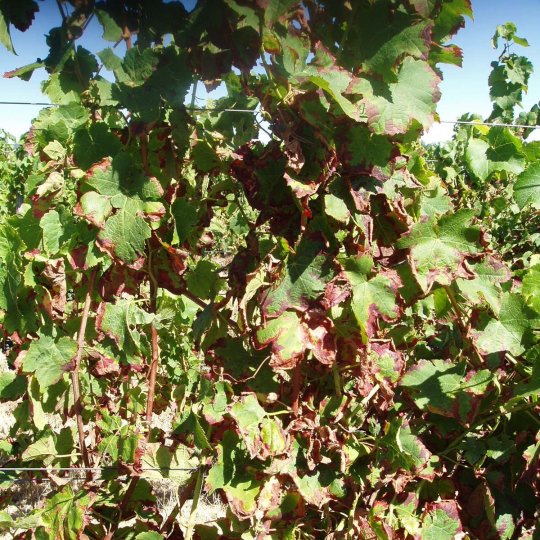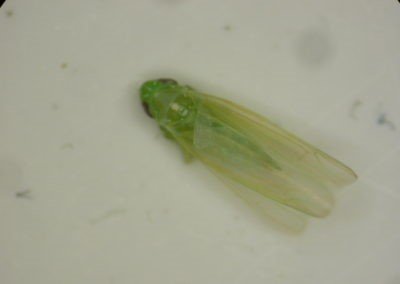The green leafhopper (Empoasca vitis) is a biting-sucking insect of the homoptera order. It is considered to be a secondary grapevine pest. Large populations of larvae can give vines a scorched appearance.
2.4.3.a Green leafhopper or vine leafhopper
What damage does the green leafhopper cause in the vineyard?
Initial green leafhopper damage appears as reddening at the edges of leaves in red grape varieties, or yellowing in white grape varieties, delimited by the smaller veins: spots with polygonal outlines resembling a mosaic. Outbreaks begin towards the end of June on the leaves at the vine's base. The discolouration spreads to the centre of the leaf, while the edges dry up, turn brown and give the leaf a scorched appearance. The damage becomes more pronounced in August and September. The scorched leaves have reduced photosynthetic activity, and a decrease in sugar content as well as a delay in ripeness may be observed.
Are there any diseases with which it could be confused?
Potassium and magnesium deficiencies can also cause reddening/yellowing at the edges of leaves, which over time becomes more pronounced and progressively extends to the leaf's centre. However, these symptoms do not display a mosaic effect and the veins remain unaffected. Green leafhopper damage causes dryness which, when the leaves turn brown/scorched, can slightly undulate and resemble leaf curling. Finally, mites can cause leaf reddening which also appears in a mosaic form, but is not limited to the extremities, which makes it possible to distinguish these symptoms from those of leafhoppers.
How can the green leafhopper be recognized?
These leafhoppers are invariably found on the underside of leaves. The adults are green or pink, about 3 mm long, and move or fly away quickly. The larvae are white at first, turn green or pink and move around in a "crab-like" manner. The size of the larvae is less than 1 mm for the first larval stage and 3 mm for the fifth (wing tips). The eggs are translucent, white and elongated (0.7 mm). They are rarely observable because they are located in the veins.
What is the biology of the green leafhopper?
Adults spend the winter on evergreen shrubs or conifers. The females first migrate to relay plants in the spring (roses, brambles), before moving to the grape vines towards the end of April where they lay between 15 to 20 eggs in the veins. After an incubation period of 8 to 10 days, the first larvae appear. There are 5 larval stages. The entire cycle requires 55 to 60 days. Depending on the year and the region, there can be two to four generations, but it is the second generation (July-August) that has the greatest number of larvae and causes the most damage.
Extracts from Vigne Vin Occitanie.
Are there any preventive measures?
There are not many preventive measures for the green leafhopper. This pest seems to be found mostly in orchards near vineyards. When that is the case, it is advisable to monitor the green leafhopper population early in the season by counting them. Some measures can be taken:
-
Vigorous vines with high leaf density have a greater potential to attract green leafhoppers. Excessive nitrogen applications can lead to an increase in leaf density and contribute to this risk.
-
Maintaining grass cover and/or slopes can allow the installation of beneficial populations such as Anagrus atomus, spiders, carabid beetles and other species that prey on green leafhoppers.
-
Other methods can be used in organic viticulture such as calcined kaolinite (white clay). When sprayed on the foliage, it forms a good plant cover, this mechanical barrier disrupts the leafhopper's movement, feeding and oviposition.
In addition, the clay slightly "whitens" the foliage, making it less attractive to these insects. Clay is also used to prevent leaf sunburn. Be careful, however, as coverage of the foliage may also reduce photosynthesis.
What treatments are available?
Officially there is no specific control treatment for the green leafhopper in organic winegrowing, but the use of a pyrethrum-based insecticide (authorized in organic agriculture) can be effective in controlling this pest.
The green leafhopper cycle can begin prior to flowering (April) and last until véraison (August). In order to reduce the establishment of populations, their egg-laying and their development through the different larval stages, it is advisable to set up regular (weekly) counts in the vineyard of approximately a hundred leaves, ideally in calm weather in the morning when the temperature is still cool and the humidity high. Traps can be used but another method is to gently and randomly turn over leaves from any leaf stage to observe the underside. This task can be difficult, as green leafhoppers are fast, and can jump and fly. When counting, care must be taken not to count the moulting larvae as well. When the counts indicate a significant population, it is advisable to treat.
The intervention threshold is 100 larvae per 100 leaves around flowering (May-June), and 50 larvae per 100 leaves in the summer (July-August). However, a revision of these thresholds is in progress, with thresholds of 100 larvae per 100 leaves currently being considered during the summer as well. Populations of 200 larvae per 100 leaves have been observed, without any consequence for grape quality and ripening. Moreover, there seems to be a cumulative role of the larvae: the population accumulation over an extended period appears to be more significant than the population level at a given time (e.g. 15 days of occupation of 100 leaves by 50 larvae, could be a threshold to consider). There is no biological control in the strict sense. Work carried out by IFV Bourgogne and Gilles Sentenac showed that Anagrus atomus, a parasitoid of this leafhopper, has a high rate of parasitism, but the results were irregular.
Extract from Vigne Vin Occitanie.



